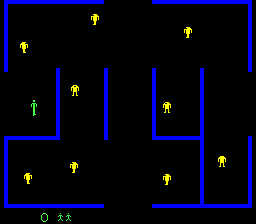
Berzerk is an eerie and malevolent game. Visually and conceptually simple – the stick figure player wanders around the screen from room to room avoiding stick figure robots programmed to kill him – the whole bleakly addictive shebang is presided over by a horrible smiley killjoy called Evil Otto. The atmosphere is foreboding and, while playing for extended lengths, it is not hard to reach the chirpy conclusion that you’ve inadvertently unleashed some ghastly being which will be hiding just behind you, dodging out of sight no matter how quickly you spin around, for the rest of your life. Berzerk has the unhappy distinction of being the only video game to have directly killed people playing it: 19 year old Jeff Dailey suffered a fatal heart attack after achieving a slightly creepy 16,660 in January 1981, and fifteen months later, 18 year old Peter Burkowski also died from heart failure during a long session in which he posted two consecutive high scores at his local arcade in Mitchigan.
So, brace yourself and whistle a cheery tune to keep your spirits up as complete our Pac Man Fever odyssey by taking a wander around the murky yet brilliant world of Berzerk.
Berzerk’s perfectly affable and nice creator, Alan McNeil, had the idea
for the game after dreaming about fighting robots in a room from which
he could not seem to escape. Drawing heavily on an elderly BASIC game
called Daleks which was released in the late seventeenth century, he
produced Berzerk. It’s not a difficult game to grasp. You are
represented by a humanoid type stick figure, controlled by a joystick,
who uses a laser pistol to kill not-that-clever robots as he navigates
screen after screen of increasingly complex room layouts, which are, in
effect, mazes. There are a lot of mazes. Sixty four thousand
consecutively trickier mazes, in fact. Perhaps fittingly for a game
which would take a great deal of dedication to master, it was market
tested in a singles bar in Chicago before being released worldwide, and
was originally to be graphically monochrome – which would have been
quite stylish, in retrospect. However, the success of the riotously
colourful and generally mindblowing Defender saw a last minute recall
of the game to have it fitted with a colour overlay board for its full
public debut in the summer of 1980.
The player can be killed by all the things you might expect from a game
featuring evil robots. If a robot shoots you, you die. If it
touches you, you die. You’ll probably catch a nasty cold if one coughs
on you. It’s all pretty standard stuff. However, if you hang about
too long in a room, Evil Otto comes boucing towards you, with all the
bonhomie of a hand grenade with a novelty wig on. Otto – named after
a highly disliked colleague of McNeil’s – is unusual in the world of
video game baddies in that he absolutley cannot be killed. Indeed,
he’s a grinning mentalist, and will happily atomise any robots who
happen to be standing between the pair of you as he commences his death
bounce. Robots come in a range of different colours, from the chilled
out yellow ones that can’t shoot at you, to the really very annoyed
indeed red ones that will blaze away like the poorly animated maniacs
they are. However, there is much, much more to Berzerk than filling
the air with electric death and hoping for the best.

The great thing about Evil Otto, as we have observed, is that he kills
everything. This means that he can be coaxed into killing things that
aren’t you. For example, by manouvering yourself behind a couple of
hapless metal automatons, you can watch Otto plough straight through
your clumsy assailants and then neatly dodge as he whistles past.
Indeed, this is the tactic that all the cool kids favour to amass very
high scores indeed. Also, robots can be lured into walking into
walls, which will kill them, and also shooting each other.
Considering that only a limited number of robot laser bolts can be on
the screen at the same time, the thinking player can bob and weave his
way through several thousand levels before going completely nuts.
Berzerk has another great thing going for it, as well. It was one of
the first arcade games to feature a real, actual, and proper speech
track. This was an extremely expensive undertaking in 1980, costing
around £600 per word, at a time when houses cost about £4.50. The game
has a vocabulary of thirty words, arranged into a suprising variety of
phrases ranging from the slightly alarming ‘Coin detected in pocket!’
which would ring out while the high score list was being displayed, to
the ‘Chicken! Fight like a robot!’ challenge that robots would issue,
usually just before walking into a wall and dying. To increase the
amount of robot chatter, the speed and pitch of each phrase is varied
and mixed with appropriate words such as ‘Kill!’ or ‘Intruder!’ or
‘Attack!’ to give the very convincing impression that a babbling legion
of metal zombies is descending upon the player.
And there we must leave Berzerk, and wave a fond farewell to the whole
Pac Man Fever album, which has unwittingly served as a snapshot of
arguably the most creative period of video gaming. Except, that is,
for Cat n Mouse at track nine, which is blatently just Pac Man but with
cats and mice in it. All in all, then, we can thank Buckner and
Garcia for their lyrical snapshot of happy gaming days gone by, and
rest assured in the knowledge that it is an album which is better to
read about than actually listen to.

Comments are closed.